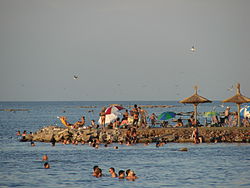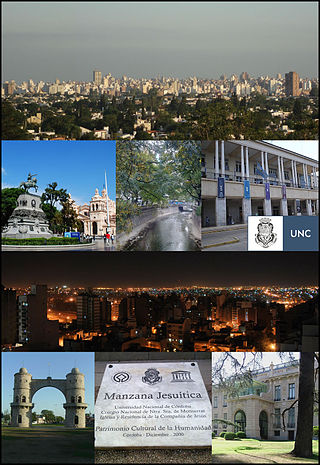
Córdoba is a city in central Argentina, in the foothills of the Sierras Chicas on the Suquía River, about 700 km (435 mi) northwest of Buenos Aires. It is the capital of Córdoba Province and the second-most populous city in Argentina after Buenos Aires, with about 1.6 million urban inhabitants according to the 2020 census. A European settlement was founded on 6 July 1573 by Jerónimo Luis de Cabrera, who named it after Córdoba, Spain. It was one of the early Spanish colonial capitals of the region of present-day Argentina. The National University of Córdoba, the oldest university of the country, was founded in 1613 by the Jesuit Order, and Córdoba has earned the nickname La Docta.

Buenos Aires, officially the Buenos Aires Province, is the largest and most populous Argentine province. It takes its name from the city of Buenos Aires, the capital of the country, which used to be part of the province and the province's capital until it was federalized in 1880. Since then, in spite of bearing the same name, the province does not include Buenos Aires city, though it does include all other parts of the Greater Buenos Aires metropolitan area. The capital of the province is the city of La Plata, founded in 1882.
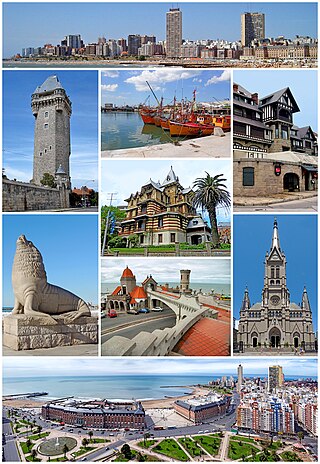
Mar del Plata is a city on the coast of the Atlantic Ocean, in Buenos Aires Province, Argentina. It is the seat of General Pueyrredón district. Mar del Plata is the second largest city in Buenos Aires Province. The name "Mar del Plata" is a shortening of "Mar del Rio de la Plata," and has the meaning of "sea of the Rio de la Plata basin" or "adjoining sea to the (River) Plate region". Mar del Plata is one of the major fishing ports and the biggest seaside beach resort in Argentina. With a population of 682,605 as per the 2022 census [INDEC], it is the 5th largest city in Argentina.
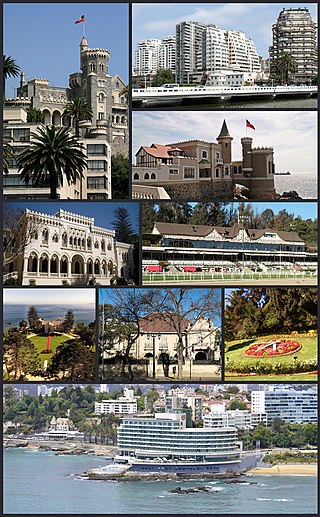
Viña del Mar is a city and commune on central Chile's Pacific coast. Often referred to as La Ciudad Jardín, Viña del Mar is located within the Valparaíso Region, and it is Chile's fourth largest city with a population of 324,836. Viña del Mar is also part of the Greater Valparaíso area, the country's second largest metropolitan area, after the Metropolitan area of Santiago. The Greater Valparaíso Area is home to five municipalities: Valparaíso, Viña del Mar, Concon, Quilpue and Villa Alemana.

The Costa del Sol is a region in the south of Spain in the autonomous community of Andalusia, comprising the coastal towns and communities along the coastline of the Province of Málaga and the eastern part of Campo de Gibraltar in Cádiz. Formerly made up only of a series of small fishing settlements, today the region is a world-renowned tourist destination. The Costa del Sol is situated between two lesser known coastal regions, the Costa de la Luz and the Costa Tropical.

Argentina has a vast territory and a variety of climates and microclimates ranging from tundra and polar in the south to the tropical climate in the north, through a vast expanse of temperate climate. Natural wonders include the Aconcagua, the highest mountain in the world outside the Himalayas, the widest river and estuary of the planet, the Iguazú Falls, the Humid Pampas, and the Argentine Sea. Visitors enjoy the culture, customs and Argentine cuisine.
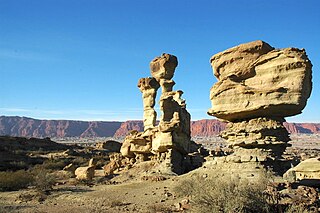
San Juan Province is a province of Argentina, located in the western part of the country. Neighbouring provinces are, moving clockwise from the north, La Rioja, San Luis and Mendoza. It borders with Chile to the west.
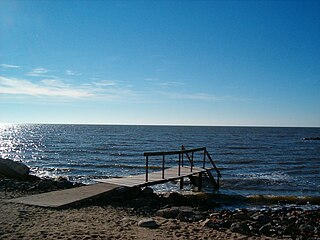
Mar Chiquita or Mar de Ansenuza is an endorheic salt lake located in the northeast of the province of Córdoba, in central Argentina. The northeast corner of the lake also extends into southeastern Santiago del Estero Province. It is the largest of the naturally occurring saline lakes in Argentina. The lake is located in parts of five departments in the two provinces.

The Estadio Mario Alberto Kempes, formerly known as Estadio Córdoba, is a stadium in the Chateau Carreras neighborhood of Córdoba, Argentina. Owned by the Córdoba Province, the venue is used mostly for association football and rugby union matches and also sometimes for athletics.

La Falda is a town in the province of Córdoba, Argentina, located 79 km (49 mi) from Córdoba and 800 km from Buenos Aires. It had about 15,000 inhabitants at the 2001 census [INDEC].

Villa Carlos Paz is a city in the center-north of the province of Córdoba, Argentina, in the south of the Punilla Valley, lying on the western slope of the Sierras Chicas. It has a population of about 56,000 as per the 2001 census [INDEC]. The area of Punilla is a major tourist destination on the national level, and Villa Carlos Paz is in turn the most important city of Punilla, favoured by its closeness to the populous Córdoba City, the capital of the province. Popular tourist activities include bathing in one of the many rivers, fishing, evening shows, kite surfing, windsurfing, hiking and mountain biking.

The architecture of Argentina can be said to start at the beginning of the Spanish colonisation, though it was in the 18th century that the cities of the country reached their splendour. Cities like Córdoba, Salta, Mendoza, and also Buenos Aires conserved most their historical Spanish colonial architecture in spite of their urban growth.

General Alvarado Partido is a partido on the Atlantic Coast of Buenos Aires Province in Argentina.

Miramar is an Argentine city located on the coast of the Atlantic Ocean in Buenos Aires Province, 450 km (280 mi) south of Buenos Aires. It is the administrative seat of General Alvarado Partido. The name “Miramar” comes from the words mira (view) and mar (sea).
Morteros is a city and municipality in the San Justo Departament in the north east of the Córdoba Province, Argentina.

San Justo Department is a department of Córdoba Province in Argentina.

Provincial Route 11 is a 583-kilometre-long (362 mi) Argentine road in the East of Buenos Aires Province. The road extends from Punta Lara to the town of Mar del Sur.

Córdoba is a province of Argentina, located in the center of the country. Its neighboring provinces are Santiago del Estero, Santa Fe, Buenos Aires, La Pampa, San Luis, La Rioja, and Catamarca. Together with Santa Fe and Entre Ríos, the province is part of the economic and political association known as the Center Region.
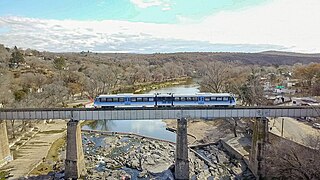
Tren de las Sierras is a 150.8 km (93.7 mi) regional rail line in Córdoba Province of Argentina. The line runs from Alta Córdoba to Cosquín, being currently operated by state-owned company Trenes Argentinos.

Alberto Nicasio was an Argentine artist (xylographer) and educator. He was a member of the Argentinian National Academy of Arts. A street in the city of Córdoba and a primary school in the province are named after him.
